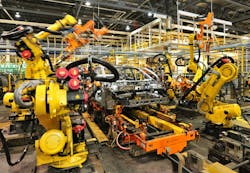Starting in 2008, the Global Powertrain Manufacturing Engineering group at Ford Motor Co. spent the next two years developing the architecture for an automation foundation that could serve as the basis for production improvements and allow the company to take advantage of technology advances. Three strategic initiatives lie at the heart of this foundation: standardization, flexibility, and acceleration.
Areas of focus for standardization included: operational efficiency, reduced engineering resources, decreased time to market, enabling continuous improvement, and energy efficiency. For flexibility, which addresses machining and assembly operation, Ford wanted to be able to use different suppliers’ products within a system and be able to reuse or redeploy assets as necessary. The acceleration initiative focused on ensuring integration of various systems from Tier 1 suppliers along with reduced installation time and effort, i.e., getting as much plug-and-play as possible.
In his ARC Forum presentation at the Profinet-hosted session on “Enabling the Information-Driven Enterprise”, Mike Bastian, controls manager for Ford’s Global Powertrain group, said, “I’m a big believer in distributed controls,” as he explained Ford’s emphasis on using distributed control products to create its manufacturing IT footprint.
Creating this footprint required the Ford Powertrain group to focus on several aspects of software and system integration. For software, Ford zeroed in on assembly station function blocks, HMI screens, transport control, smart device interfaces, CNC path planning and machine control, robot programming framework, and computerized maintenance management programming. The group’s overall system integration focus centered on IT system interfaces, recipe complexity management, IP addressing and network designs, data collection strategies, traceability, and quality control.
The overriding goals for these areas of increased focus was to create a “best in world manufacturing” operation that would provide Ford with “standard, easy to reconfigure assembly systems and provide more control over how our systems operate in production,” Bastian said. Having this controls framework in place would also allow Ford to take advantage of enhanced simulation methods, employ virtual commissioning, and create discrete event models with IT validation.
Bastian noted that Profinet serves as the Ford Powertrain Group’s plant layer network, not only connecting automation and control systems, but enabling data from the plant floor to be accessed by enterprise IT. Beyond connecting all the systems in Ford’s manufacturing IT footprint, Profinet is also enabling Ford to take the next steps in advancing its production operations.
Material planning, data management, process control and system integration are all key areas of focus starting in 2014 for Ford, Bastian said. Specific projects in these areas enabled by Profinet include gauging integration and CNC control, next-generation HMI displays using PC-based products with operator identification, energy management operations related to machine states and supervisory tools, use of automated guided vehicles, wireless applications for machine connectivity and HMIs, dunnage tracking, inventory management, and scheduling systems. More collaborative human-robot interaction will also be among the top-of-list automation activities for Ford moving forward.
Data management will be a particular area of concentration, Bastian said, noting that, like most large manufacturers, “we struggle with information management because we collect so much of it.”
In light of the recent rebound in U.S. automotive manufacturing, Ford’s automation and networking plans are likely emblematic of manufacturing technology advances occurring throughout the U.S. automotive sector. While introducing Bastian at the Profinet ARC Forum session, Raj Batra, president of Industry Automation at Siemens, pointed out that the U.S. is quickly emerging as a “bright spot” in the global automotive space. “Vehicle sales are reaching a five-year high due to pent-up demand and easier credit.” Batra noted that, as a result of the booming U.S. auto business, he sees more “plants investing in modernization of their automation systems rather than just adding shifts and plants.”

